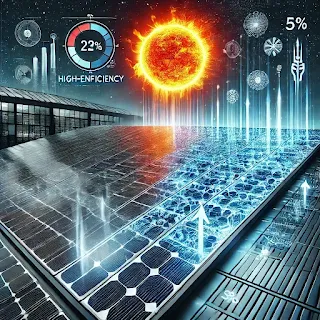Introduction
Solar energy continues to be one of the most promising renewable energy sources, driving innovation in high-efficiency solar cells. As technology advances, researchers and manufacturers are developing new materials and designs that maximize energy conversion. However, one critical factor affecting solar cell performance is temperature. Excessive heat can reduce efficiency and degrade solar panels over time.
This article explores the latest advancements in high-efficiency solar cells and examines how temperature variations impact solar cell performance.
Advancements in High-Efficiency Solar Cells
The efficiency of a solar cell refers to its ability to convert sunlight into usable electricity. Traditional silicon-based solar cells have dominated the market, but newer technologies are pushing efficiency beyond previous limits.
1. Perovskite Solar Cells
High Efficiency: Perovskite solar cells have reached efficiency levels above 30% in laboratory settings.
Low Manufacturing Costs: These cells use inexpensive materials and solution-based fabrication techniques.
Flexibility: Unlike rigid silicon panels, perovskites can be applied to flexible substrates.
2. Tandem Solar Cells
Multi-Junction Efficiency: Stacking different materials (such as silicon and perovskite) increases energy absorption.
Improved Light Utilization: Each layer captures a different part of the solar spectrum, boosting efficiency.
Record-Breaking Performance: Some tandem cells have exceeded 40% efficiency in research labs.
3. Quantum Dot Solar Cells
Nanotechnology Integration: Quantum dots enable better light absorption and electron transport.
Potential for Ultra-High Efficiency: These cells can theoretically surpass traditional limits with multi-exciton generation.
Lightweight and Transparent Applications: Ideal for integration into windows, vehicles, and wearables.
4. Heterojunction Solar Cells (HJT)
Low Recombination Losses: Combining crystalline silicon with thin amorphous silicon layers reduces energy loss.
Higher Temperature Tolerance: HJT cells perform well in hot environments, maintaining efficiency better than traditional silicon cells.
Commercial Viability: Many manufacturers are scaling up HJT production for mass adoption.
5. Passivated Emitter and Rear Cell (PERC) Technology
Enhanced Light Trapping: PERC cells have a rear-side passivation layer that improves efficiency.
Better Performance in Low Light: They generate more power in cloudy or shaded conditions.
Widespread Adoption: Many commercial solar panels now incorporate PERC technology.
Impact of Temperature on Solar Cell
Performance Temperature plays a crucial role in the efficiency and longevity of solar cells. While solar panels convert sunlight into electricity, they also absorb heat, which can negatively impact their performance.
1. The Temperature Coefficient
Definition: The temperature coefficient indicates how much efficiency decreases with each degree Celsius increase in temperature.
Typical Values: Most silicon-based panels have a temperature coefficient between -0.3% to -0.5% per °C.
Practical Effect: A 25°C rise in temperature can reduce a panel’s efficiency by 7.5% to 12.5%.
2. Heat-Induced Efficiency Loss
Increased Resistance: Higher temperatures increase internal resistance, reducing current flow.
Reduced Bandgap Energy: Heat lowers the bandgap of semiconductor materials, decreasing voltage output.
Thermal Degradation: Prolonged exposure to high temperatures accelerates material degradation and reduces lifespan.
3. Cooling Solutions and Mitigation Strategies
Passive Cooling Methods:
Reflective coatings reduce heat absorption.
Elevated mounting systems improve airflow beneath panels.
Active Cooling Techniques:
Water or air cooling systems can actively dissipate heat.
Phase-change materials (PCMs) absorb excess heat, stabilizing panel temperature.
Material Innovations:
HJT and perovskite-based solar cells are more resistant to heat-related efficiency loss.
4. Regional Considerations for Temperature Effects
Hot Climates: High temperatures in desert regions significantly impact efficiency, requiring better heat management.
Cold Climates: Lower temperatures can actually improve performance, as solar cells operate more efficiently in cooler conditions.
Urban vs. Rural Installations: Rooftop panels in cities may experience more heat buildup than ground-mounted rural systems.
Future of High-Efficiency and Temperature-Resistant Solar Cells
Research is ongoing to develop solar cells that are both highly efficient and resilient to temperature fluctuations. Future advancements include:
Self-Cooling Solar Panels: Materials that dissipate heat more effectively.
AI-Optimized Solar Farms: Smart tracking systems that adjust panel angles to minimize overheating.
Hybrid Solar Technologies: Combining PV with solar thermal systems to utilize excess heat for energy production.
Next-Generation Materials: Silicon alternatives like perovskites, quantum dots, and organic photovoltaics with better thermal stability.
Conclusion
The evolution of high-efficiency solar cells is driving the solar industry toward greater energy conversion rates and cost-effectiveness. However, managing the impact of temperature on solar panels remains a key challenge. By leveraging innovative materials, advanced cooling strategies, and optimized system designs, the future of solar energy will be more efficient and resilient to environmental conditions.
As researchers continue to push the boundaries of solar cell efficiency, the integration of temperature-resistant technologies will play a crucial role in maximizing the potential of solar power across different climates and applications.

No comments:
Post a Comment